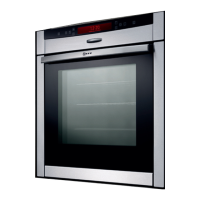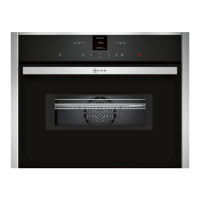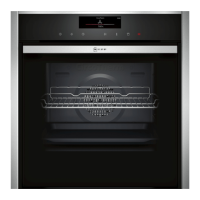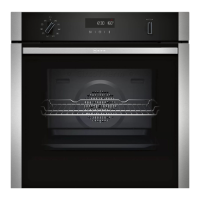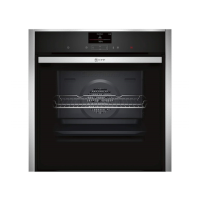12
Roasting
In this section, you will find information on
■ roasting in general
■ roasting without a lid
■ roasting with a lid
■ roasting meat, poultry and fish (roasting table)
■ tips and tricks for roasting
ã=There is a risk of injury if you use roasting dishes that
are not heat-resistant!
Only use roasting dishes that are marked as being suitable for
use in the oven.
Do not use shelf height 2 when roasting with
3 CircoTherm®.
The air circulation would be impaired and this will have a
negative effect on your roast.
Open roasting
For open roasting, a roasting dish without a lid is used.
When you are roasting with
% Top/bottom heat, you should
turn the roast approximately half to two thirds of the way
through the roasting time.
Roasting in the universal pan
Juices escape from the roasting meat and are collected in the
universal pan. You can use these juices as the basis for a tasty
gravy.
Deglaze the pan of the juices with hot water, stock, wine or
similar. Bring to the boil, thicken with cornflour, season and
pass through a sieve if necessary.
You can also cook side dishes (e.g. vegetables) at the same
time as roasting meat in the universal pan.
For smaller joints, you can use a smaller roasting dish instead
of the universal pan. Place this directly on the wire rack.
Roasting in the universal pan with stepped wire rack
Place the stepped wire rack on the universal pan and slide
them in together at the same shelf height.
For fatty meat and poultry, add
X to ¼ litre water to the
universal pan, depending on the size and type of the joint.
While the meat is roasting, the liquid in the roasting dish will
evaporate. Pour in more hot water if required.
Roasting in the universal pan with roasting sheet
The roasting sheet reduces dirt in the cooking compartment.
Place the roasting sheet in the universal pan and slide them in
together at the same shelf height.
Dripping fat and meat juices are caught in the universal pan.
Roasting with a lid
This method is particularly suitable for pot roasts.
Place the joint in the roasting dish. Add water, wine, vinegar or
similar for the braising liquid. Place the lid on the dish, place
the dish on the wire rack and slide it into the cooking
compartment.
While the meat is roasting, the liquid in the roasting dish will
evaporate. Pour in more hot water if required.
The cake is too moist in the centre Set a slightly lower temperature.
Note: Higher temperatures do not necessarily mean shorter baking times (cooked on
the outside, but not on the inside). Select a longer baking time and allow the cake mix-
ture to prove for longer. Add less liquid to the mixture.
With very moist cakes, e.g. fruit flans, a lot
of steam is generated in the cooking com-
partment which condenses on the appli-
ance door.
If you briefly and carefully open the appliance door (once or twice, or more often for
longer baking times), you can let the steam out of the cooking compartment and con-
siderably lessen the condensation.
The cake collapses when you take it out of
the oven
Use less liquid for the mixture.
Set a longer baking time or a slightly lower temperature.
The specified baking time is not correct For small items, check the quantity on the baking tray. The items must not be touching
each other.
Frozen products are not browned evenly
after baking
Check whether the frozen product is unevenly browned before baking. This uneven
browning will remain after the baking time.
Frozen products are not browned, not
crispy or the specified time is not correct
Remove ice from frozen products before baking. Do not use frozen products that are
heavily frosted
Saving energy Only preheat the appliance when it is specified in the baking table that you should do
so.
Use dark baking tins as these absorb the heat better.
Make use of the residual heat with longer baking times and switch the oven off
5 10 minutes before the end of the baking time.

